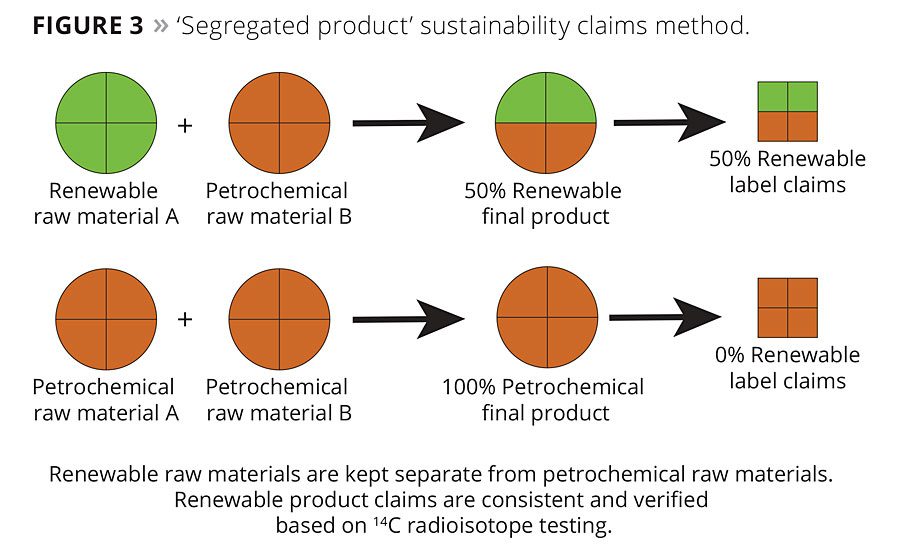Sustainable Sustainability Claims








By Lee Colyer Speight, Ph.D., Manager, Technology & Downstream Products; and Christopher J. Lanci, Ph.D., Manager, Downstream Business Development, North America, Green Biologics Inc., Abingdon, Oxon, U.K.; and Douglas Mazeffa, Environmental Project Manager, The Sherwin-Williams Company, Cleveland, OH
Greenwashing, or the practice of misrepresenting or over representing the environmental benefits of a product or practice, is common in consumer marketing. The term was coined in 1986 by Jay Westervelt to describe the still-used practice of hotel chains encouraging patrons to reuse towels and sheets under the guise of environmental stewardship. Westervelt felt that such practices were ruses – in his mind, the hotel chains were simply hoping for decreased energy or water bills and thus greater profit margins.
To many within the coatings industry, the terms ‘renewable raw materials’, ‘sustainable practices’ and ‘green chemistry’ have real and tangible meanings. However, to the average consumer these terms blur and are often commonly understood to showcase the environmentally friendly nature of a product. This dissonance is confusing, and unfortunately, for a robustly science-based industry like coatings, is used opportunistically by PR and advertising gurus. Nearly all consumer-facing markets are experiencing a deluge of greenwashing as each of these industries attempts to keep up with public opinion.
The crux of greenwashing is that the public is often unaware that green claims can be rigorously quantified beyond common notions of carbon emissions reductions, decreased toxicity, and waste recycling and reduction. As a performance-based market sector, the coatings industry is uniquely positioned to lead public educational efforts about the types of green claims that make scientific sense and the methods for verifying them. Coatings involve complex raw materials, energy-intensive formulations or applications, varying performance lifetimes, and vastly different degrees of recyclability and/or biodegradation. Each of these facets can be, and generally are, monitored in varying degrees by all of the leading companies in the coatings industry.
As illustrated by Tony Mash in an April 2015 article in Paint & Coatings Industry (PCI) magazine, the rule of thumb for the environmental impact of coatings splits the responsibility across three areas: 10% is due to formulation; 40% is due to downstream usage, lifetime and disposal; and 50% comes from the impact of the raw material manufacturing. Mash also highlights in his article that many efforts by coatings companies have focused on the combined 50% of formulation and downstream usage aspects of their coatings’ environmental impacts, as these were the “low-hanging fruit” for the major players in the industry. Additionally, it could be argued, particularly from a scientist or marketing manager standpoint, that improved performance, product lifetime and less energy-intensive formulations are more intellectually stimulating and immediately appealing to end users.
However, consumers are becoming more scrupulous and eager for products that do it all – high performance, affordable cost and minimal environmental impact. Looking to the food ingredients industry and the cosmetics and personal care industry, sustainable raw material sourcing and traceability thereof are hot topics. In products ranging from fruit snacks and peanut butter to nail polish and eye shadow, marketers of food and personal care companies are working hard to highlight gluten-free, GMO-free, and ‘all-natural’ products, but, as highlighted in random interviews done by late night host Jimmy Kimmel, consumers often do not understand what any of these claims really mean. To consumers, these taglines mean a product is better and more natural – often with little to no corroboration. This is not a universal truth however, as there are examples of food and cosmetic industry responses to the public’s interest in natural, responsibly sourced raw materials in a structured, sustained and specific manner. A great example of this is an ingredient used extensively in both food and personal care products – palm kernel oil.
In the past, palm oil plantations came under scrutiny for aggressive deforestation and encroachment onto land used by mammal species of concern such as orangutans. As a result, several non-governmental organizations (NGOs) and concerned consumers threatened to stop using products containing palm oil. As one might imagine, this was a PR nightmare, as the performance benefits consumers were experiencing in products that used palm oil, particularly in the food and personal care markets, were being overshadowed by news about unsustainable practices in the products’ supply chain. In 2004, the Roundtable on Sustainable Palm Oil (RSPO) was established to grow the usage of sustainable oil products from the palm tree kernel through credible global standards and engagement of stakeholders. It is crucial to highlight the wording of this mission statement: the RSPO believes that they can grow usage (i.e. increase profitability) of palm oil products by creation of credible global standards and engagement of stakeholders. Is it too much of a reach to think the same could be done for raw materials in the coatings industry?
Sustainable Sourcing
RSPO is keen to highlight three distinct methods of raw material sourcing that can be used by the coatings industry to make three different types of claims. First, there is ‘book and claim’, which is a certificate trading system (Figure 1). This works as follows: formulators and other users of a given raw material that can be sourced sustainably purchase said raw material and a certificate for each unit (e.g. tonne) purchased. It is important to note that not all of the raw material purchased has to come from a sustainable source; certificates can be purchased to count for traditional sourcing and as an ‘offset’ (similar to carbon trading). This, while complicated, allows for companies to support the development of a sustainable raw material when the actual purchase price, logistics or available volumes do not suit the present needs of the purchaser. Furthermore, from a marketing perspective, it allows a company to make verifiable claims that they are monetarily supporting sustainability in their supply chain.
The second method of sustainability for raw material sourcing highlighted by RSPO is called ‘mass balance’ (Figure 2). In this method, raw material purchasers and formulators buy both sustainably sourced raw materials as well as traditional material. These two streams are co-mingled, but the total volume of material sold as “certified sustainable” cannot exceed the verifiable volumes of actual sustainable materials that were purchased. In practice, mass balance claims can vary. A common example is: 25% of raw material X was sustainably sourced in the manufacturing of product Y for year ABCD. Volumes are verified by purchases, basically by bookkeeping of the purchaser, not certificates. Furthermore, each batch of formulated product is not checked to see if it also contains the same % of sustainable raw material; under mass balance, 25% of batches could be 100% sustainable and 75% could be 0%, and the aforementioned claim would still be valid.
The third, and arguably most transparent method highlighted by RSPO is called ‘segregated product lines’ (Figure 3). As the name implies, raw material purchasers keep 100% of the sustainably sourced raw material completely segregated from traditionally sourced materials throughout the supply chain. This means that if the value chain for a product involves the initial purchase of raw material, which is then transformed or processed by one party and then sold to another for further processing before ending up in the final consumer’s hands, each leg in this process must be completely segregated. Convoluted as this may sound, products utilizing sustainably sourced materials that go through segregated product lines can be verified with a simple test; radiocarbon dating, or 14C testing. Sustainably sourced raw materials containing carbon atoms (e.g. nearly everything, save for hydrogen and oxygen gases) contain a higher amount of 14C than traditionally sourced materials. Verification by credible and industry-accepted methods, e.g. ATSM-6866, can be performed by organizations such as universities and analytical testing facilities.
Segregated product lines provide a potent method for verification through radiocarbon dating and as such are favored by governmental programs such as the USDA’s BioPreferred®program, which combines voluntary labeling and mandatory federal purchasing guidelines to increase the use of biobased sustainable finished goods. Mass balance methods of sustainably sourced raw materials can also work with these types of programs if there is little to no batch-to-batch variation in the ingredient sourcing. For example, if a penetrating lubricant is made of 68% sustainably sourced raw materials and 32% traditionally sourced raw materials, and can pass ASTM 6866 showing 68% each batch, it can be labeled USDA BioPreferred as a 68% biobased penetrating lubricant.
Life Cycle Assessment
It is not the author’s intention to communicate this information to the reader as if it was simple or even easy to follow. The truth is that with myriad of options for sustainable sourcing, a unified method of analyzing the total inputs to a product, as well as industry experts to calculate this are both needed and desired by our industry. Clearly, sustainable raw material sourcing must be considered in addition to, not separate from, all other aspects of the way a product is produced, used, and eventually discarded or reused. As was mentioned earlier, Tony Mash noted that the rule of thumb for environmental impact of coatings is only 50% due to raw material sourcing. How does one tie in the other half? One such unified method is called life cycle assessment (LCA), a complex subject that requires an expert to explain. Douglas Mazeffa, Environmental Project Manager from The Sherwin-Williams Company, graciously provided the following comments:
“Although life cycle assessment (LCA) has been around since the 1960s, it has only recently been gaining popularity within the coatings industry. This increase in popularity has largely come from increasing requests through green building programs such as LEED v4, Green Globes and the International Green Construction Code. However, creating an LCA for a product is not trivial and it is important to understand its structure, benefits and limitations before formally conducting studies.
LCA is a form of environmental impact assessment that tracks several environmental indicators throughout the entire life cycle of a product (Figure 4). Said another way, LCA uses a cradle-to-grave approach as opposed to only considering one area of a product’s life cycle (application or disposal, for example). LCA also goes well beyond other forms of impact benchmarking such as carbon footprinting because it tracks several environmental indicators (usually around a half-dozen). By doing this, LCA prevents burden-shifting, meaning the creation of unintended environmental consequences when optimizing the environmental performance of a product.
LCA operates through a mass balance that tracks all inputs and outputs throughout the supply chain. Inputs include energy, water and any raw materials, and outputs include wastes, pollution, emissions, by-products and the finished product itself. There are a number of international standards that govern the structure of an LCA, including ISO 14040, 14044 and 14025. For building material products such as coatings, ISO 21930 and EN 15804 are important as well.
There are several different forms of LCA, but the most common type is called process-based or attributional LCA. All forms of LCA are data-intensive, and it is usually recommended to perform a screening or hotspot LCA as a first step to help determine where to focus data collection and other research efforts.
An important distinction of LCA is that it uses what is called a ‘functional unit’ as its basis for comparison. A functional unit considers the quantity, quality and duration of the service provided by the product(s) being studied. In an LCA for an architectural coating, for example, this means comparing how much of a coating it takes to cover an area of substrate, how well the coating covers the substrate, and how long the substrate remains adequately covered. This sort of approach is superior to simply comparing an arbitrary quantity of coatings to draw environmental conclusions.
Because LCA tracks so many indicators, it is common to have tradeoffs between products. For example, product ‘A’ may have a lower impact in global warming, acidification and smog formation, but a larger impact in toxicity, eutrophication and ozone depletion. This can make decision making difficult. However, it is important to stress that all business decisions impact the environment in unique ways and should not be over-simplified or ignored. There are a variety of ways tradeoffs can be addressed, but a case-to-case decision is often the best way to proceed.
The demand for LCAs is being primarily driven by LEED v4, which gives up to two points for products that have what are called Environmental Product Declarations (EPDs). The easiest way to describe an EPD is as a nutrition label, but rather than fat, calories, protein, etc., it lists the environmental indicators from an LCA. Not only is conducting an LCA the only way to create an EPD, but it also needs to follow a formal set of guidelines based on its relevant product category (called a Product Category Rule or PCR). Earlier this summer, the American Coatings Association published the first PCR for architectural coatings in the United States, which means that any coating manufacturer is able to pursue the publication of EPDs at this time. This PCR is available through NSF or at www.paint.org.
LCAs are already fairly common in the marketplace, especially industries such as automotive, electronics, clothing, food and flooring, which have been progressive in getting LCAs into the hands of their customers. LCAs are still more common in Europe, but have been rapidly increasing in popularity in the United States over the past decade.
The main challenge for LCA and EPDs is the generally limited experience of the individuals who often end up using these documents. PCRs, LCAs and EPDs are highly technical documents and difficult to interpret accurately without formal training. Currently, the pathway to improve the quality of training and increase the knowledge base of design professionals is unclear and inconsistent. However, this move towards environmental impact transparency will undoubtedly lead to a better understanding of the impacts of buildings in time.”
Conclusion
No single document, speech or industrial committee can clarify the murky waters of sustainability claims. As Douglas Mazeffa points out, the technical complexities of LCAs and EPDs are a tremendous barrier to transparency in claims – the same can be said for all sustainability arguments, especially for raw material sourcing. The intent of this article is to highlight the vast complexities facing the coatings industry as it continues to respond to consumer and regulatory demands for “more environmentally friendly products.”
Traceable and verifiable methods of sustainability for raw material sourcing, formulation methodology and testing product performance are essential for a science-based industry moving to address consumer demands for green products. Several other industries have found success in doing so, and their transformations have given rise to NGOs and other groups that aggressively support the sustainable sourcing of key raw materials and better practices. It is important to note that the average consumer can easily change brands of food or cosmetics if they discover the supplier’s claims to be greenwashed, but the same cannot be said for the paint on the walls of the consumer’s house. Thus, if one wants to inspire loyalty in this market, claims must be correct and verifiable the first time as the cost barrier to “trying something again” is too high in the case of the average consumer. The same could be said about product performance – inferior products are not acceptable in any case, especially not as a result of greenwashing. If the coatings industry wants to adequately respond to growing consumer demand for traceable, sustainable, affordable and high-performing products, transparency is essential. Without transparency and regular communication of the details of our claims, we are simply asking our customers to kindly reuse their towels. Verifiably sourcing sustainable raw materials combined with LCA and other analyses might just be the best place to start.
Looking for a reprint of this article?
From high-res PDFs to custom plaques, order your copy today!










